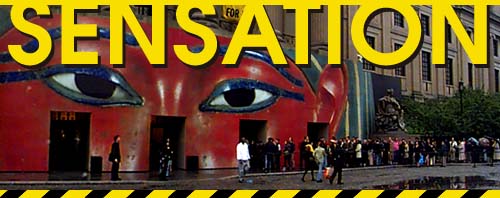
The following is a review of the current, controversy ridden, Young British Artists' Exhibit at the Brooklyn Museum which is being shown thanks to the collection owner, Charles Saatchi. Even a review of this exhibit needs a warning that you may be offended by some of what you see.
The focus of the SENSATION controversy is a single "painting" which is part of a series of very colorful canvases incorporating paper collage, colored pushpins, foil, paint, glitter and, yes, elephant manure. The offending painting, called The Holy Virgin Mary, is in a style that reminds me of Peter Max and the pointillist impressionist, Seurat. Geometric shapes suggest a face and torso while the canvas is attractively enhanced with thousands of tiny colored dots. The dots are dimensional, being formed from drops of paint and adhered glitter. The work looks more like a tapestry than a painting. Oh yes, the controversy... along with the myriad of adornments is a prominent chunk of elephant turd, about the size of a baseball, stuck to the figure's right side. Elephants eat vegetation, so their excrement is mostly undigested plant fiber which decays as it passes through their digestive system. In some African cultures this dung is a vital source of fuel. It's also used like plaster in constructing homes where trees are scarce. Many remote villagers undoubtedly would place more value in a good pachyderm poop than gold. Indeed many African cultures had no real use for gold until their contact with Europeans. But I am digressing.
I traveled to Brooklyn as much to satisfy my curiosity as to show my support for the museum and its courage to withstand the volleys from these hopeful politicians and "born-agains". In New York City, the locals spoke of "checking out" the exhibit, but their enthusiasm was dulled by the din of similar battles that play out daily in the world's navel. While waiting for the Number 2 train in midtown, I met a crowd of fellow dung pilgrims and we all had to endure the ranting of a small black woman, who, with Bible in hand (Gallatians 3, I will never forget), begged us all to turn away from our debauchery. Her raspy and extremely loud voice seemed to be powered by an Energizer. As the train arrived, she boarded my car and continued her shrill all the way to the East Parkway Station. The subway portal is conveniently located directly in front of the Brooklyn Museum. It was raining heavy. I was curious to see how many other people braved the wrath of Mother Nature's tears to see this important piece of dung. Climbing the steps towards the gray sky I could hear an army of voices reciting the "Hail Mary" mantra. Armed with signs and a public address system they stood, clad in black plastic trash bags that were fashioned into rain coats, glaring at the assemblage. They were kept at bay by New York's finest, who seemed amused at the whole scene. The Brooklyn Museum is quite large and has a facade painted to resemble the famous pair of eyes adorning a Buddhist Temple in Katmandu in Nepal - a sight that has welcomed so many other pilgrims. The line was already long and was comprised of a mixed group. Many people were joining the museum's society to show their support for artistic freedom. There were even many families with young children that had come specifically to see this exhibit. The SENSATION Exhibit fills many large rooms of the museum's third and fourth floor. It contains the work of dozens of young British artists who are pushing the artistic envelope. The Brits seem to be the only ones actively pursuing this noble effort and the negative reaction of New York do-gooders gives some indication of what American artists must confront in this politically charged "land of the free.". Visitors are first greeted with a number of large canvas works which are colorful, clever and experimental. Visual effects are fabricated in ways that compel you to walk up and examine the intricacies and inspect how the paint was applied. It is as much a lesson in how our minds view reality as it is an appreciation of the artists' talents. The exhibit name, SENSATION, has both a subjective and objective meaning. In this exhibit, both meanings merge. Another room contains large tanks made of glass with white painted steel frames. The tanks are filled with a kind of greenish fluid and, suspended or affixed with wire and tacks in each of the tanks, there are a series of "slices" of a cow. This is the work of Damian Hirst. You might think that it would be interesting to see the inner workings of your favorite entrée but the effect is anything but. The liquid that was used to fix and preserve the specimens has rendered the various structures a "dull gray" and so the consecutive filets looked like soggy old newspaper floating in an aquarium.
The painting is beautiful and visually interesting. African born, Ofili utilizes a palette of tropical colors, so different from the bovine artifacts in the adjoining gallery. The mood is festive. The focus of the controversy was a small round chunk of manure that had hardened to a solid dry ball. It was placed on the painting with the same apparent respect as gilding was used in the Renaissance. The dung itself was decorated with dozens of colorful pushpins that were arranged in concentric circles. Rather than hang his works on the gallery wall, Ofili chose to prop his work atop pairs of decorated poop - yet another utilitarian use for the material in areas with no wood. Ofili's other paintings were not protected. In fact, while I was looking at one up-close and personal, I could smell the scent of Africa and almost hear the screaming roar and the flash of tusks. A toddler had bent down and was stroking one of the mysterious blobs until his mother saw him and, somewhat hesitant to admonish him publicly, simply said ,"Don't touch!" "Why?" "Just don't touch." "But why?" As nice as they were, I doubt that any of the pieces I had seen so far, including the Virgin, deserved any publicity at all. Those who were offended surely had only increased the exposure and interest in what would have otherwise been a obscure and dim show. In fact, so much attention was focused on Olifi's work that the "moral right" completely missed their real opportunity to muster indignation against the exhibit. Their more opportune target, as I was to discover, was in the very next room. In my own appreciation of art I like to be "freaked out." I enjoy seeing works which engage the viewer and perform the role of "true art," which is to instruct and to stimulate. Jake and Dinos Chapman's sculptures are such an extreme example of this that they deserved to be the real "front page story" of this British show. "Zygotic acceleration, biogenetic, de-sublimated libidinal model (enlarged x 1000)" (below) is a 1995 life-size sculpture that consists of a collection of female and male body parts, arranged in such a manner that they first embarrass, arouse and shame the viewer. Step closer and examine the subtle details and you will again recycle the same mix of emotions. The title suggests that this represents a potential birth defect, like Siamese twins, hermaphrodites or a three-legged side show act. The difference, of course, is that this sculpture of silicone and acrylic is designed to be sensual (in a vulgar and graphic way) yet it commands your respect for the skill of the artists in both their use of the material and their knowledge of the human psyche. There is even humor in the sculpture in that all of the tiny feet are clad in identical black Fila sneakers.
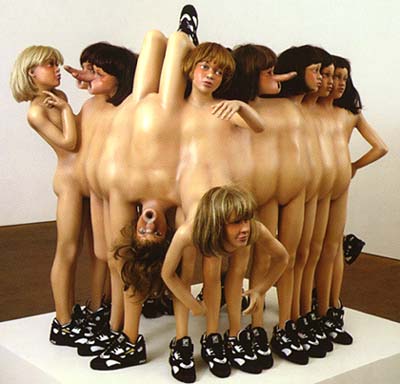
The only other item of interest was Sarah Lucas's "Au Natural." A filthy and yellow stained mattress was partially propped up against the museum wall. Embedded in the mattress were symbolic vulgar metaphors of male and female anatomy, such as a real pair of melons, a rusty bucket and the proverbial phallic cucumber. I thought the photograph was more impressive that the actual item and it made me wonder if anyone had actually paid hard cash for this. The melons and other vegetables were real and I could smell them starting to go bad. I guess then they will be replaced. Some lucky melons right now are waiting to be "discovered" in a crate in a Korean market on Lexington and 50th. On the elevator going back to the museum lobby there were some parents with young children. Having seen the exhibit one had to wonder what was going through these young minds. There was awkward silence until one young girl announced that she had decided to wear a penis on her nose for Halloween. We all laughed hysterically.
If you are thinking about visiting the museum during this exhibit I would highly recommend that you go. Show your support for the arts and for our freedom of expression. Whomever controls our dreams will ultimately control our destiny. Even if you don't appreciate the dried dung or the erotic sculptures you can always make up for the effort by stopping for a memorable meal at Ya'ads. And instead of taking the subway back, stroll across the famous but deteriorating Brooklyn Bridge. Art is everywhere.
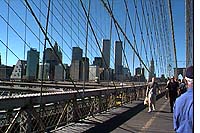 Related Viewzone stories: The Amazing Anatomic Dolls of Ryoichi Yoshida
|

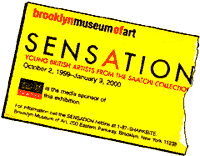 In America, turds are bad. And to affix one to a personage that many believe to be the focus of their devotion is sure to bring an outcry. In our culture we have used gold to gild the halos of our blessed saints. We have even affixed precious stones to religious icons -- but never, until now, dung. It is no surprise then that New York's mayor (running for the State's senate seat) has threatened to evict the museum from Brooklyn for displaying this one small turd. And he is not alone in his critique. I ponder how these same people would view the common and historical use of human urine as a fixative in the pigments of such devotional works as the Last Supper and the ceilings of the Vatican.
In America, turds are bad. And to affix one to a personage that many believe to be the focus of their devotion is sure to bring an outcry. In our culture we have used gold to gild the halos of our blessed saints. We have even affixed precious stones to religious icons -- but never, until now, dung. It is no surprise then that New York's mayor (running for the State's senate seat) has threatened to evict the museum from Brooklyn for displaying this one small turd. And he is not alone in his critique. I ponder how these same people would view the common and historical use of human urine as a fixative in the pigments of such devotional works as the Last Supper and the ceilings of the Vatican. 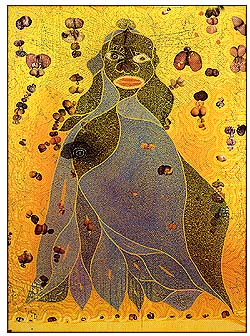 Immediately following this dismal scene is the Chris Ofili exhibit. I entered a narrow room which forces visitors to crowd and strain to view The Holy Virgin Mary (1996, made from paper collage, oil pain, glitter, polyester resin, map pins, and elephant dung on linen). If there are ten people in this small room it is three too many. To complicate matters, the precious dung (the Mecca of my pilgrimage, after all) is kept at a distance of about fifteen feet by a large piece of protective Plexiglas (bulletproof?) which has a nasty glare. I struggled to the front and had trouble discerning that this work represented a human, much less a virgin.
Immediately following this dismal scene is the Chris Ofili exhibit. I entered a narrow room which forces visitors to crowd and strain to view The Holy Virgin Mary (1996, made from paper collage, oil pain, glitter, polyester resin, map pins, and elephant dung on linen). If there are ten people in this small room it is three too many. To complicate matters, the precious dung (the Mecca of my pilgrimage, after all) is kept at a distance of about fifteen feet by a large piece of protective Plexiglas (bulletproof?) which has a nasty glare. I struggled to the front and had trouble discerning that this work represented a human, much less a virgin.
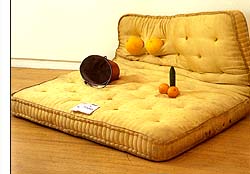 As I left the museum I was not disappointed. I had learned quite a bit about human nature, politics, and the nature of art. Instead of going straight back to Manhattan I looked for some food. I wanted to taste Brooklyn while I was here. Directly across from the museum there was a small but interesting looking place called Ya'ad Caribbean Eatery (803 Washington Ave.). As the odd name implies, they specialized in Caribbean style food. I wanted to avoid beef for the moment (I wonder why?), so founder, Keith, suggested I try some of his famous Jerked Chicken. It was absolutely delicious... or dare I say "sensational."
As I left the museum I was not disappointed. I had learned quite a bit about human nature, politics, and the nature of art. Instead of going straight back to Manhattan I looked for some food. I wanted to taste Brooklyn while I was here. Directly across from the museum there was a small but interesting looking place called Ya'ad Caribbean Eatery (803 Washington Ave.). As the odd name implies, they specialized in Caribbean style food. I wanted to avoid beef for the moment (I wonder why?), so founder, Keith, suggested I try some of his famous Jerked Chicken. It was absolutely delicious... or dare I say "sensational."